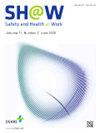Data Mining Implementations for Determining Root Causes and Precautions of Occupational Accidents in Underground Hard Coal Mining
IF 2.9
3区 医学
Q1 PUBLIC, ENVIRONMENTAL & OCCUPATIONAL HEALTH
引用次数: 0
Abstract
Background
Nowadays, as in every branch of industry, a large amount of data can be collected in mining, both in productivity and occupational safety. It is increasingly essential to transform this data into useful information for enterprises. Data mining is very useful in processing and extracting useful information from the processed data. This study aims to analyze the data of occupational accidents with injuries between 2010 and 2021 in an underground hard coal mine by data mining.
Methods
The injured accident data for the relevant years were organized and analyzed using data mining algorithms. These algorithms were implemented with the WEKA data mining program, an open-source application.
Results
According to different test methods, k-Nearest Neighborhood and Support Vector Machine algorithms succeeded in classification and prediction. The k-Nearest Neighborhood and Support Vector Machine algorithms achieved 100% (training set) and 66% (cross-validation) performance, respectively, according to two different test methods. One of the critical phases of the study is the determination of the attributes and subclasses that are effective in the origin of accidents by association rules mining. Thus, more detailed information was obtained about the root causes of the accidents. A result of Apriori and Predictive Apriori implementations revealed that the root causes of occupational accidents according to the accident locations are the worker experience, the working hours in the shift, and the worker position. In addition, shifts, accident causes, especially monthly production, and monthly wages were also influential.
Conclusions
These results are also in accordance with the actual situation in the enterprise. As a result of the research, practical suggestions were presented for evaluating occupational accidents and taking precautions.
地下硬煤开采职业事故成因及预防措施的数据挖掘实现
如今,在每一个工业分支中,采矿都可以收集到大量的数据,包括生产力和职业安全。将这些数据转化为对企业有用的信息变得越来越重要。数据挖掘在处理和从处理过的数据中提取有用信息方面非常有用。本研究采用数据挖掘的方法,对2010 - 2021年某地下硬煤煤矿工伤事故数据进行分析。方法采用数据挖掘算法对相关年份的受伤事故数据进行整理和分析。这些算法是通过开源应用程序WEKA数据挖掘程序实现的。结果根据不同的测试方法,k-最近邻和支持向量机算法在分类和预测方面取得了成功。根据两种不同的测试方法,k近邻和支持向量机算法分别达到100%(训练集)和66%(交叉验证)的性能。研究的关键阶段之一是通过关联规则挖掘确定在事故起源中有效的属性和子类。因此,获得了有关事故根本原因的更详细的信息。Apriori和Predictive Apriori的实施结果显示,根据事故地点,职业事故的根本原因是工人的经验,轮班工作时间和工人的位置。此外,班次、事故原因,特别是月产量和月工资也有影响。结论这些结果也符合企业的实际情况。研究结果为职业事故评价和预防提出了切实可行的建议。
本文章由计算机程序翻译,如有差异,请以英文原文为准。
求助全文
约1分钟内获得全文
求助全文
来源期刊

Safety and Health at Work
Social Sciences-Safety Research
CiteScore
6.40
自引率
5.70%
发文量
1080
审稿时长
38 days
期刊介绍:
Safety and Health at Work (SH@W) is an international, peer-reviewed, interdisciplinary journal published quarterly in English beginning in 2010. The journal is aimed at providing grounds for the exchange of ideas and data developed through research experience in the broad field of occupational health and safety. Articles may deal with scientific research to improve workers'' health and safety by eliminating occupational accidents and diseases, pursuing a better working life, and creating a safe and comfortable working environment. The journal focuses primarily on original articles across the whole scope of occupational health and safety, but also welcomes up-to-date review papers and short communications and commentaries on urgent issues and case studies on unique epidemiological survey, methods of accident investigation, and analysis. High priority will be given to articles on occupational epidemiology, medicine, hygiene, toxicology, nursing and health services, work safety, ergonomics, work organization, engineering of safety (mechanical, electrical, chemical, and construction), safety management and policy, and studies related to economic evaluation and its social policy and organizational aspects. Its abbreviated title is Saf Health Work.
 求助内容:
求助内容: 应助结果提醒方式:
应助结果提醒方式:


